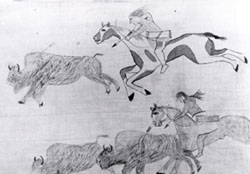|
TIMELINE |
|
|
798,000 B. C. |
| Bison begin to
cross the land bridge |
| 3000 |
| Bison bison
appears |
| |
| A. D. 1520 |
| Horses brought
to America |
| 1600 |
| 60 million
buffalo roam North America |
| 1881 |
| Frederick
Dupree saves five buffalo calves |
| 1890 |
| Buffalo nearly
extinct |
| 1901 |
| Scotty Philip
buys Dupree herd |
| 1914 |
| Custer State
Park herd started |
| 2000 |
| Buffalo
population at 250,000 |
|
Lesson 2
American Indians and the Buffalo
The Dakota, Lakota, and Nakota (Sioux) Indians
used the buffalo for food. They also used it for clothing and
shelter. Because the buffalo was so important, it had a special
place in their religion. An old story tells that the Indians once
lived underground. They called themselves Pte Oyate, or the
Buffalo Nation. One day, they came to the surface to live. Here,
life was hard. A holy man named Tatanka came to them as a buffalo.
He gave the people everything they needed. Today, one Indian name
for the buffalo is
tatanka.
The
buffalo moved in herds. The Dakota, Lakota, and Nakota people had
to move with them. They lived a
nomadic
lifestyle. They followed the buffalo to new grasslands or
pastures. Hunting was hard before white people brought horses to
the Americas. Most of the tribe had to help hunt the buffalo. The
people would herd the animals into a canyon or corral. Hunters
killed the penned animals. One of these ancient "kill
sites" is found near the town of Buffalo, South Dakota. |
|
Sometimes the tribe
forced a herd to
stampede off a high cliff. This is called
a "buffalo jump." Most animals died in the fall.
Others were killed with spears and arrows. Then the tribe cut up
the animals. There are buffalo jump sites in South Dakota.
One is south of Lemmon. It is
near Shadehill Reservoir. Arrowheads and bones from thousands of
buffalo were found there. They were below a steep cliff.
|

Photo courtesy of South Dakota State
Historical Society
|
| |
|
|
Other times, hunters pretended
to be wolves. They put on wolf skins. They crept close to the
herd. They shot the buffalo with arrows. Buffalo were not afraid
of wolves. They ignored the men in wolf skins.
|
It took fewer hunters to
kill buffalo after the Indians got horses. Each hunter had a fast
"buffalo horse." Man and horse chased the
buffalo. The hunter shot it. The women cut the buffalo up. They
hauled the parts back to camp.
|
| |
|
.jpg)
Winter
Count
|
The Indians used
almost every part of the buffalo. The tongue, heart,
liver, and back
fat were special treats.
The muscle meat was cut into strips. The strips were dried to make
jerky. They were hung on trees and branches in the sun. Jerky was
an important food. It lasted a long time and was easy to carry.
|
| |
|
The Indians used jerky to
make
wasna. The women pounded the
dried meat into a fine meal. They mixed it with wild berries and fat. Sometimes they
packed it into clean buffalo
intestines. It was like a sausage. Usually they kept wasna in
rawhide containers. These holders were called
parfleches.
|
|
|
The Indians used the
tanned hide of the buffalo to make tipis, clothing, and bedding.
First, the women stretched the hides. Then they scraped them to
clear away fat and flesh. Next they worked in a mixture of cooked
brains. Then they let the skins dry in the sun.
They soaked the hides and dried them again.
|
Two women pulled a hide
back and forth over a tree branch. They were making it soft. The
hide was then ready to be made into clothing or tipis. Rawhide, or
hide that was not tanned, was used for shoes, or moccasins. It was
also used for shields and ropes.
|
Buffalo hair was made
into horse ropes and the lining of clothes. From bones, the
Indians made arrows and scrapers. They also made knives, axes, and
hammers. Flat bones made good cutting boards. Even toys were made
from bones!
|
Horns became spoons,
dippers, and bowls. Teeth and hooves became necklaces, door
rattles, and glue. Buffalo bladders made good containers for
liquids.
|
Another important buffalo
product was dried dung. It made good fuel. It burned without much
smoke. It did not smell either.
|
| Vocabulary |
|
| nomadic
(adj.), wandering without a permanent home
parfleches
(n.), rawhide containers
stampede
(n.), a sudden charge of scared animals
|
tatanka
(n.), Lakota name for buffalo
wasna (n.),
dried meat pounded and mixed with fat and dried fruit
|
|
|